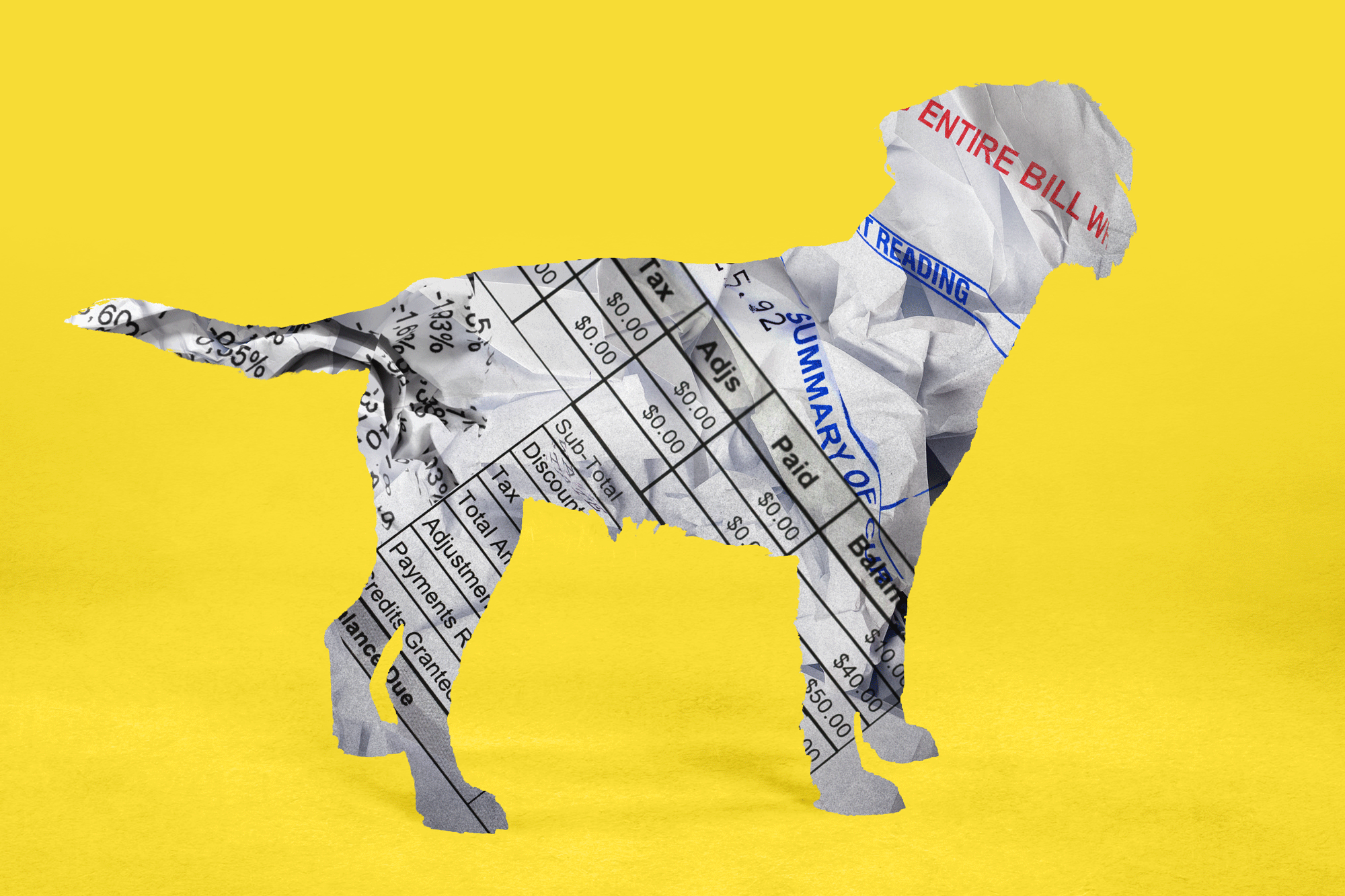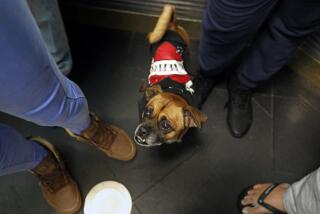Caring for pets with cancer
Weekday mornings, Mona Rosenberg joins about a dozen technicians and fellow oncologists in a circle in the back room of her clinic to prepare for the day’s cancer patients.
They open the patients’ files and fire off questions and suggestions about treatment. It’s the kind of meeting that could happen in any clinic but with an important difference: The patients at Rosenberg’s Veterinary Cancer Group have four legs.
Mainly dogs and cats come their way; sometimes the practice gets a rabbit or horse at its offices in Culver City and Tustin.
“We have Moose,” Rosenberg said during a recent gathering. “He’s a 4 1/2 -year-old chocolate brown Labrador retriever and he had a mast tumor on his scrotum.”
Rosenberg, and many others, didn’t think this now-routine morning meeting would have been possible 17 years ago when she opened her practice. But treating animal cancer has become a multimillion-dollar business and Veterinary Cancer Group has grown with it.
“In the old days it was ‘My pet is sick, so let’s put it to sleep,’ ” Rosenberg said. “And a lot of vets still weren’t knowledgeable about animal oncology themselves. But if you would have asked me then if it would grow into what it is today, I would have said, ‘No way.’ ”
Since then, Veterinary Cancer Group has expanded into a group of nine oncologists, an acupuncturist, two offices and the resources to perform X-rays, blood tests, surgeries, radiation, chemotherapy, cryotherapy and immunotherapy on animals.
The Tustin clinic also runs an animal oncology residency program for veterinarians looking to break into the specialty.
“Nobody works in isolation here,” Rosenberg said. “We get together every morning, all the doctors, all the nurses, the desk person, and we go through every patient we’re going to see that day and we give recommendations on what the best thing to do with each patient is. If we’re stumped, we just turn our chair around and someone is always there with an answer.”
Treatment methods for animals and humans are similar, said Jarred Lyons, a radiation oncologist at the Veterinary Cancer Group’s Culver City office.
“Well, tissue is tissue, just one is connected to a person [and] one is connected to an animal,” Lyons said. “We use exactly the same machinery, we use the same procedures. Sometimes that’s a surprise to people.”
Treatment costs for pets vary from a few hundred dollars to a few thousand, he said, depending on how widespread the cancer is through an animal’s body and how long the treatment lasts.
A large part of what the oncologists at the clinic do is education-based, Lyons said, adding that consultations with new patients and their owners run about an hour to explain the treatment options.
But owners aren’t the only ones who need a bit of education on animal oncology. It’s only within the last decade that animal oncology has become a mandatory part of veterinary school, Lyons said.
“This field is still small and catching on,” he said. “I’m one of 65 vet radiation oncologists in the world. But our numbers are growing each year and pet owners are smarter and taking better care of their animals, so the demand for us is growing too.”
Another factor in the field’s growth is that pets are living longer as owners take them to the vet more today than they did 20 years ago, Lyons said. Cancer is the leading cause of death among cats and dogs older than 10 years, he said.
“With us it’s really about the quality of the life,” Lyons said. “A lot of what we do is geared toward not making the animal sick. We don’t want to make the treatment worse than the disease itself, and it’s what you’re willing to put your pet through.”
Often, treating pet cancer doesn’t mean curing the cancer but extending how much time a dog or cat has left, Lyons said.
“We have that option of letting our animals go and sometimes that’s the best thing to let them go, but we can almost always let them live longer and with dignity and comfort so they don’t even realize they are sick,” he said.
“On a human level, that’s not really an option,” Lyons said. “We don’t want to let people go, so we put ourselves through a lot more pain because there is a difference in the way we view our lives and the way a pet’s life is viewed.”
Challenging preconceived notions of cancer treatment also is a part of the job at the Veterinary Cancer Group.
When Jim and Faith Pickett brought their dog Moose to the clinic’s Tustin location after his tumor was removed, the couple had a lot of questions. But they were sure of one thing.
“We always said we wouldn’t do chemo with Moose,” Faith Pickett said. “We don’t want to put our dog through all that pain.”
Rosenberg told the Picketts that dogs’ and cats’ reactions to cancer treatments often are very different from people’s. Humans often become sick and lose weight during chemotherapy, whereas only about 15% of dogs and 10% of cats suffer such side effects.
“Psychologically, animals aren’t dealing with the same baggage that we deal with when we go through cancer treatment,” Rosenberg said. “They start in a much better space than we do, and nobody’s telling them that they’re going to get horribly sick so they don’t talk themselves into some of the things we do.”
After an ultrasound, X-rays, a CAT scan and tests of Moose’s blood, bone marrow, spleen and liver, the clinic found no signs of cancer in the Labrador. But Rosenberg warned the Picketts that free-floating cancer cells could be loose in Moose’s body, advising chemotherapy as a way to get rid of whatever could be left. After going back to their primary-care vet for a second opinion, the Picketts took Rosenberg’s advice. Moose began a six-month chemotherapy treatment two weeks ago, Faith Pickett said, with no side effects so far.
“Our dogs -- they’re family and we have to do the best we can to make sure they have the best lives possible,” Pickett said. “So we decided that it’s worth the risk.”
The uncertainty of cancer treatment is a feeling that movie camera operator Diane Farrell knows all too well. Her 13-year-old dog, Zena, is in treatment for a third time.
“If she’s not suffering, putting her down is not an option,” Farrell said. “They treat animals here better than most people are treated in hospitals. They always sit on the floor with your pets, and I’ve never seen them forget a dog or cat’s name.”
Remembering all those names is tough to do. The Veterinary Cancer Group saw an average of 373 patients a week last year, treating more than 19,000 in all, Rosenberg said.
“We don’t see any patients without cancer,” Rosenberg said. “That’s what we’re good at, that’s what we do and that’s what we focus on.”
The clinic has seen a few more owners than usual passing on cancer treatment over the last six months because of the economic downturn, but not a significant drop. This doesn’t surprise Skip Barchan, whose cat Lucy is a three-time cancer survivor and cat Sam is undergoing treatment now.
“I think a lot of us who bring our pets here feel a bit of responsibility,” Barchan said. “If they have cancer and we’re fortunate enough to have the resources to take care of them, then it’s not even a question.”
--
nathan.olivarezgiles@latimes.com
--
BEGIN TEXT OF INFOBOX
Veterinary Cancer Group
Business: Veterinary Cancer Group opened 17 years ago to treat cancer in animals. The once-rare specialty has boomed, and the practice now has offices in Culver City and Tustin.
Owner: Mona Rosenberg
Revenue: $8.3 million in 2008
Employees: 56
Productivity: More than 19,000 pets treated last year


